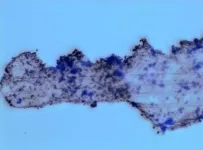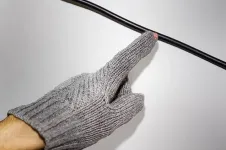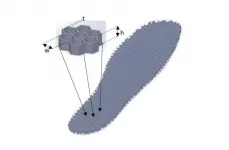Bacteria-sized robots take on microplastics and win by breaking them down
2021-06-09
(Press-News.org) Small pieces of plastic are everywhere, stretching from urban environments to pristine wilderness. Left to their own devices, it can take hundreds of years for them to degrade completely. Catalysts activated by sunlight could speed up the process, but getting these compounds to interact with microplastics is difficult. In a proof-of-concept study, researchers reporting in ACS Applied Materials & Interfaces developed self-propelled microrobots that can swim, attach to plastics and break them down.
While plastic products are omnipresent indoors, plastic waste and broken bits now litter the outdoors, too. The smallest of these - microplastics less than 5 mm in size - are hard to pick up and remove. In addition, they can adsorb heavy metals and pollutants, potentially harming humans or animals if accidently consumed. So, previous researchers proposed a low-energy way to get rid of plastics in the environment by using catalysts that use sunlight to produce highly reactive compounds that break down these types of polymers. However, getting the catalysts and tiny plastic pieces in contact with each other is challenging and usually requires pretreatments or bulky mechanical stirrers, which aren't easily scaled-up. Martin Pumera and colleagues wanted to create a sunlight-propelled catalyst that moves toward and latches onto microparticles and dismantles them.
To transform a catalytic material into light-driven microrobots, the researchers made star-shaped particles of bismuth vanadate and then evenly coated the 4-8 μm-wide structures with magnetic iron oxide. The microrobots could swim down a maze of channels and interact with microplastic pieces along their entire lengths. The researchers found that under visible light, microrobots strongly glommed on to four common types of plastics. The team then illuminated pieces of the four plastics covered with the microrobot catalyst for seven days in a dilute hydrogen peroxide solution. They observed that the plastic lost 3% of its weight and that the surface texture for all types changed from smooth to pitted, and small molecules and components of the plastics were found in the left-over solution. The researchers say the self-propelled microrobot catalysts pave the way toward systems that can capture and degrade microplastics in hard-to-reach-locations.
INFORMATION:
The authors acknowledge funding from the European Regional Development Fund.
The abstract that accompanies this paper can be viewed here.
The American Chemical Society (ACS) is a nonprofit organization chartered by the U.S. Congress. ACS' mission is to advance the broader chemistry enterprise and its practitioners for the benefit of Earth and all its people. The Society is a global leader in promoting excellence in science education and providing access to chemistry-related information and research through its multiple research solutions, peer-reviewed journals, scientific conferences, eBooks and weekly news periodical Chemical & Engineering News. ACS journals are among the most cited, most trusted and most read within the scientific literature; however, ACS itself does not conduct chemical research. As a leader in scientific information solutions, its CAS division partners with global innovators to accelerate breakthroughs by curating, connecting and analyzing the world's scientific knowledge. ACS' main offices are in Washington, D.C., and Columbus, Ohio.
To automatically receive news releases from the American Chemical Society, contact newsroom@acs.org.
Follow us: Twitter | Facebook
[Attachments] See images for this press release:

ELSE PRESS RELEASES FROM THIS DATE:
2021-06-09
TORONTO, June 9, 2021 - Researchers from York University and the University of British Columbia have found social media use to be one of the factors related to the spread of COVID-19 within dozens of countries during the early stages of the pandemic.
The researchers say this finding resembles other examples of social media misinformation ranging from the initial phase of vaccine rollout to the 2021 Capitol riot in the United States.
Countries with high social media use leading to off-line political action prior to the pandemic, as surveyed before the pandemic by V-Dem (a database from the University of Gothenburg), showed ...
2021-06-09
Skoltech researchers and their colleagues from RAS Institute for Physics of Microstructures, Lobachevsky State University of Nizhny Novgorod, ITMO University, Lomonosov Moscow State University, and A.M. Prokhorov General Physics Institute have found a way to increase photoluminescence in silicon, the notoriously poor emitter and absorber of photons at the heart of all modern electronics. This discovery may pave the way to photonic integrated circuits, boosting their performance. The paper was published in the journal Laser and Photonics Reviews.
"Natural selection" in semiconductor technology ...
2021-06-09
Vertebrate life began in the water, but around 340-360 million years ago, four-limbed creatures, or tetrapods, made the transition onto land. In the years that followed, some species adapted to terrestrial life, while others turned back to the water and readapted to an aquatic lifestyle.
A new study of these early amphibians, published in the journal PLOS ONE and led by Penn paleontologist Aja Carter, suggests that these environmental shifts left an impression--on the shape of the animals' spines.
"I'm interested in how the shapes of the vertebrae affect how animals move," she says. "Our findings suggest that, in at least one part of the vertebrae, the shape of the bones ...
2021-06-09
WEST LAFAYETTE, Ind. - Purdue University engineers have developed a method to transform existing cloth items into battery-free wearables resistant to laundry. These smart clothes are powered wirelessly through a flexible, silk-based coil sewn on the textile.
In the near future, all your clothes will become smart. These smart cloths will outperform conventional passive garments, thanks to their miniaturized electronic circuits and sensors, which will allow you to seamlessly communicate with your phone, computer, car and other machines. This smart clothing will not only make you more productive but also check on your health status and even call for help if you suffer an accident. The reason why this smart clothing ...
2021-06-09
As many as 450,000 Americans die every year from a sudden, fatal heart condition, and in slightly more than one in ten cases the cause remains unexplained even after an autopsy. Researchers from the University of Maryland School of Medicine (UMSOM) and their colleagues found that nearly 20 percent of patients with unexplained sudden cardiac death - most of whom were under age 50 - carried rare genetic variants. These variants likely raised their risk of sudden cardiac death. In some cases, their deaths may have been prevented if their doctors had known about their genetic predisposition to heart disease. The study findings were published ...
2021-06-09
WASHINGTON--After their initial blast, space rockets shoot away from the Earth with rumbles in infrasound, soundwaves too low to be heard by human ears that can travel thousands of miles.
New research used a system for monitoring nuclear tests to track the infrasound from 1,001 rocket launches. The research identified the distinctive sounds from seven different types of rockets, including the Space Shuttles, Falcon 9 rockets, various Soyuz rockets, the European Space Agency's Ariane 5, Russian Protons and several types of Chinese Long March rockets.
In some cases, like the Space Shuttle and the Falcon 9, the researchers were also able to identify the various stages of the rockets' journey.
https://youtu.be/IfMtEcNkkho
The ...
2021-06-09
Smokers needed their blocked arteries fixed nearly a decade earlier than non-smokers, and patients with obesity underwent these procedures four years earlier than non-obese patients, according to a new statewide study.
The research included patients without a history of heart attack who were treated at hospitals across Michigan participating in BMC2, the Blue Cross Blue Shield of Michigan Cardiovascular Consortium. The patients had undergone angioplasty and/or stenting to widen or unblock their coronary arteries and restore blood flow. Almost all of them had at least one traditional ...
2021-06-09
Millions of people with diabetes are at risk of developing foot ulcers, which often lead to amputations and other health complications. Now, Scientists from the Centre for Biomechanics and Rehabilitation Technologies (CRBT) have developed a new method to reliably detect this risk without the need for complex electronic in-shoe sensors.
Dr Panagiotis Chatzistergos, Associate Professor in Orthopaedic Biomechanics, explained: "In the UK alone, 169 people have a toe, foot or limb amputated as a result of diabetes every week, yet importantly up to 80% of these amputations could have been prevented with correct management.
"Routine overloading ...
2021-06-09
New research shows what is often assumed to be 'fair' in conservation practice may not be considered so by the very people most affected by it--and a new approach is needed if protected areas are to be effective.
Lead author Dr Georgina Gurney, from the ARC Centre of Excellence for Coral Reef Studies based at James Cook University, said considering local stakeholder conceptions of fairness in conservation is critical.
"If conservation is perceived as unfair it can lead to conflict, undermining support and cooperation," Dr Gurney said.
She said it is not only an ethical matter but key to achieving good ...
2021-06-09
University of Illinois Chicago researchers studying birth outcomes in marmoset monkeys found there were no adult maternal characteristics like age or weight gain during pregnancy to predict stillbirth or early neonatal death, but that a mother's birth weight or litter size were associated with early neonatal death.
"Our findings of early life contributions to adult pregnancy outcomes in the common marmoset disrupt mother-blaming narratives of pregnancy outcomes in humans," the paper states.
Julienne Rutherford, associate professor at UIC's School of Nursing, is lead author of "Womb to Womb: Maternal litter size and birth weight but not adult characteristics predict early neonatal death of offspring in the common marmoset monkey" published in the journal PLOS ONE.
Marmosets ...
LAST 30 PRESS RELEASES:
[Press-News.org] Bacteria-sized robots take on microplastics and win by breaking them down



